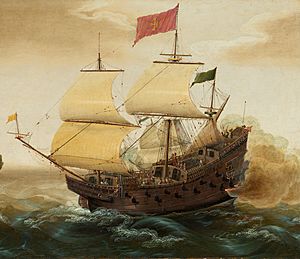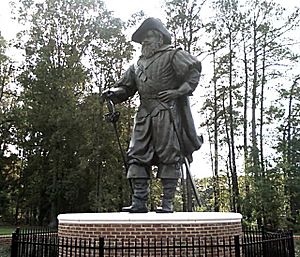Battle of Puerto Caballos (1603) facts for kids
Quick facts for kids Battle of Puerto Caballos (1603) |
|||||||
|---|---|---|---|---|---|---|---|
| Part of the Anglo–Spanish War | |||||||
 A Spanish galleon similar to the one Newport captured at Puerto Caballos |
|||||||
|
|||||||
| Belligerents | |||||||
| Commanders and leaders | |||||||
| Juan de Monasterio | Christopher Newport Michael Geare |
||||||
| Strength | |||||||
| 2 galleons, 100 militia onshore |
8 ships, 400 men |
||||||
| Casualties and losses | |||||||
| Fortress destroyed 1 galleon burnt 1 galleon captured 2 merchant ships captured 230 killed, wounded, or captured |
30 casualties | ||||||
The Battle of Puerto Caballos was an important fight during the Anglo-Spanish War. It happened on February 17, 1603. English and French ships attacked the Spanish town and port of Puerto Caballos. Today, this place is called Puerto Cortés in Honduras. The English fleet was led by Christopher Newport and Michael Geare. After a tough battle, the English and French won. They captured two large Spanish ships called galleons. One of these ships was later burned. The attackers stayed in the area for two weeks. They took many valuable things before leaving.
Why the Battle Happened
During the Anglo-Spanish War, English privateers often attacked Spanish ships. Privateers were like legal pirates. They were private ships allowed by their government to attack enemy ships. Many of these privateers were London merchants. They sailed along the coast of the Spanish New World. Their goal was to weaken Spain by taking its goods.
One famous privateer was Christopher Newport. He was a very experienced sailor. Newport had been in the Caribbean since 1602. He even lost an arm during a successful trip in 1590. But this injury did not stop him from fighting.
In November 1602, Newport met Captain Michael Geare. Geare was another experienced raider. They met at a trading spot called Tortuga. This island is off the coast of Hispaniola. Geare had also teamed up with three French privateer ships. Their plan was to attack two Spanish galleons. These large ships were expected to arrive soon at Puerto Caballos.
Newport's ship was called Neptune. Geare's ship was the Archangel. Another ship, the Phoenix, joined them. They also added some captured Spanish ships to their fleet. This made their group eight ships strong.
Newport had attacked Puerto Caballos before. In May 1592, he captured a merchant ship there. So, he knew the area well. But his fleet needed supplies badly. So, they first sailed to Jamaica. On January 24, 1603, they raided Jamaica. But the Spanish fought back and pushed them away. Newport's group left with only small losses.
The Battle Begins
On February 17, 1603, the English and French ships arrived at Puerto Caballos. It was still dark. They sent out seven small boats with 200 men. These boats also carried light cannons. Their plan was to board the two Spanish galleons. These galleons were anchored in the harbor. They hoped to capture them instead of destroying them.
The two Spanish galleons were very important. One was the 600-ton Nuestra Señora del Rosario. It was commanded by Captain Juan de Monasterios. The other was the 400-ton San Juan Bautista. This ship was led by Francisco Ferrufino. These were the main ships of the Spanish fleet in New Spain.
As the sun began to rise, the attackers rowed towards the galleons. They hoped to surprise the Spanish. But their surprise attack did not work. The Spanish fired warning shots. Soon, the English and French boarded both galleons.
The Spanish soldiers fought bravely. They managed to push back the attackers for several hours. But then Newport's Neptune and Geare's Archangel arrived. They used their powerful cannons to help the attack. Both sides were very tired. Finally, the English took control of the Nuestra Señora del Rosario.
When the San Juan Bautista saw this, its crew knew it was hopeless. They surrendered soon after. Newport quickly ordered an attack on the port itself. He wanted to stop any Spanish counterattack. After a short fight, the Spanish soldiers ran away from the town. The battle was over in about eight hours. Both sides had about 30 casualties. But the Spanish had nearly 200 men surrender. Most of these were the ships' crews.
Taking Over the Town
The English and French winners then looted the ships and buildings. They spent the next eighteen days taking valuable items. They also took two merchant ships. There was a lot of loot! They found 200 sacks of anil (a blue dye). They also took 3,000 animal hides. The cannons from the two captured galleons were also taken. Plus, there were many other goods from the town.
The Rosario ship was badly damaged. It had been hit hard by Newport's and Geare's ships. Newport decided to burn it because it was too damaged to tow away. All the valuable goods from the Rosario were moved to the Bautista.
There were some arguments between the English and French. This was not about the loot. It was about the Spanish prisoners. Spanish people who saw what happened later said the French wanted to kill all the prisoners. But the English refused to let them. Newport stood firm. The English had their way and spared most prisoners. But the French still killed a few. In the last days of their stay, Newport freed many prisoners. He also arranged for some to be ransomed. The local fort, San Felipe castle, was destroyed by the attackers.
What Happened Next
Eventually, both groups left Puerto Caballos. They took only the San Juan Bautista as their prize. The Rosario was left behind as a burned wreck. The French sailed back to Hispaniola. The English headed towards Cuba. Puerto Caballos had been attacked many times before. But this was its biggest attack. The town was left ruined and never fully recovered.
Geare and Newport stayed in the Caribbean until May. They captured more Spanish ships near Havana. In that same month, they sailed safely back to England. Newport used the money from his captured prizes. He used it to help start the Virginia Company. He would return to the Americas again. This time, not to raid, but to help found the first lasting English colony. This colony was Jamestown. He worked with famous people like John Smith and John Rolfe.
See also
 In Spanish: Batalla de Puerto Caballos (1603) para niños
In Spanish: Batalla de Puerto Caballos (1603) para niños


